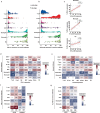Tertiary lymphoid structure-related immune infiltrates in NSCLC tumor lesions correlate with low tumor-reactivity of TIL products
- PMID: 39188755
- PMCID: PMC11346574
- DOI: 10.1080/2162402X.2024.2392898
Tertiary lymphoid structure-related immune infiltrates in NSCLC tumor lesions correlate with low tumor-reactivity of TIL products
Abstract
Adoptive transfer of tumor infiltrating lymphocytes (TIL therapy) has proven highly effective for treating solid cancers, including non-small cell lung cancer (NSCLC). However, not all patients benefit from this therapy for yet unknown reasons. Defining markers that correlate with high tumor-reactivity of the autologous TIL products is thus key for achieving better tailored immunotherapies. We questioned whether the composition of immune cell infiltrates correlated with the tumor-reactivity of expanded TIL products. Unbiased flow cytometry analysis of immune cell infiltrates of 26 early-stage and 20 late-stage NSCLC tumor lesions was used for correlations with the T cell differentiation and activation status, and with the expansion rate and anti-tumor response of generated TIL products. The composition of tumor immune infiltrates was highly variable between patients. Spearman's Rank Correlation revealed that high B cell infiltration negatively correlated with the tumor-reactivity of the patient's expanded TIL products, as defined by cytokine production upon exposure to autologous tumor digest. In-depth analysis revealed that tumor lesions with high B cell infiltrates contained tertiary lymphoid structure (TLS)-related immune infiltrates, including BCL6+ antibody-secreting B cells, IgD+BCL6+ B cells and CXCR5+BLC6+ CD4+ T cells, and higher percentages of naïve CD8+ T cells. In conclusion, the composition of immune cell infiltrates in NSCLC tumors associates with the functionality of the expanded TIL product. Our findings may thus help improve patient selection for TIL therapy.
Keywords: Immune infiltrate; NSCLC; TIL therapy; TLS formation.
© 2024 The Author(s). Published with license by Taylor & Francis Group, LLC.
Conflict of interest statement
MCW declares to have a consulting role for ONO therapeutics. JH declares to have advisory roles for AstraZeneca, Achilles Therapeutics, BioNTech, CureVac, Immunocore, Iovance Bio, Instil Bio, MSD, Molecular Partners, Neogene Therapeutics, Novartis, Roche, Sanofi, T-Knife, Third Rock Ventures. Grant support from Amgen, Asher Bio, BioNTech, BMS, Novartis, Sastra Cell Therapy. Stock options: Neogene Therapeutics, Sastra Cell Therapy. KM declares to have grant support from AstraZeneca, Amgen, Abbvie, BMS, Bayer, Boehringer Ingelheim, Benecke, Delfi, Diaceutics, Lilly, Merck, MSD, PGDx, Pfizer, Roche, Takeda, of which none are related to this work. All other authors declare to have no competing interest.
Figures





References
-
- Dudley ME, Gross CA, Langhan MM, Garcia MR, Sherry RM, Yang JC, Phan GQ, Kammula US, Hughes MS, Citrin DE, et al. CD8+ enriched “young” tumor infiltrating lymphocytes can mediate regression of metastatic melanoma. Clin Cancer Res. 2010;16(24):6122. doi: 10.1158/1078-0432.CCR-10-1297. - DOI - PMC - PubMed
-
- Besser MJ, Shapira-Frommer R, Treves AJ, Zippel D, Itzhaki O, Hershkovitz L, Levy D, Kubi A, Hovav E, Chermoshniuk N, et al. Clinical responses in a phase II study using adoptive transfer of short-term cultured tumor infiltration lymphocytes in metastatic melanoma patients. Clin Cancer Res. 2010;16(9):2646–2655. doi: 10.1158/1078-0432.CCR-10-0041. - DOI - PubMed
-
- Radvanyi LG, Bernatchez C, Zhang M, Fox PS, Miller P, Chacon J, Wu R, Lizee G, Mahoney S, Alvarado G, et al. Specific lymphocyte subsets predict response to adoptive cell therapy using expanded autologous tumor-infiltrating lymphocytes in metastatic melanoma patients. Clin Cancer Res. 2012;18(24):6758. doi: 10.1158/1078-0432.CCR-12-1177. - DOI - PMC - PubMed
MeSH terms
LinkOut - more resources
Full Text Sources
Medical
Research Materials
